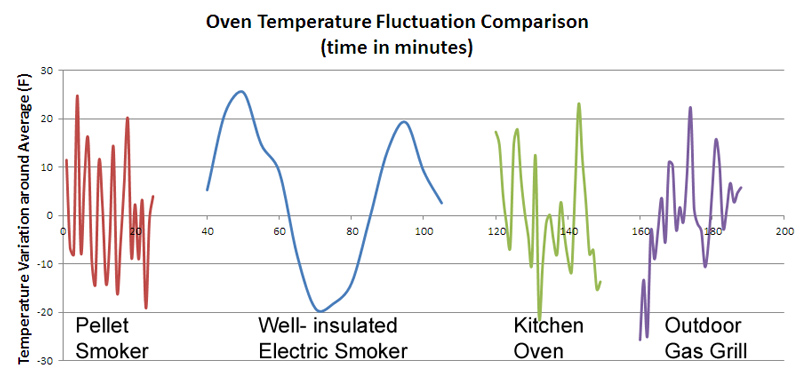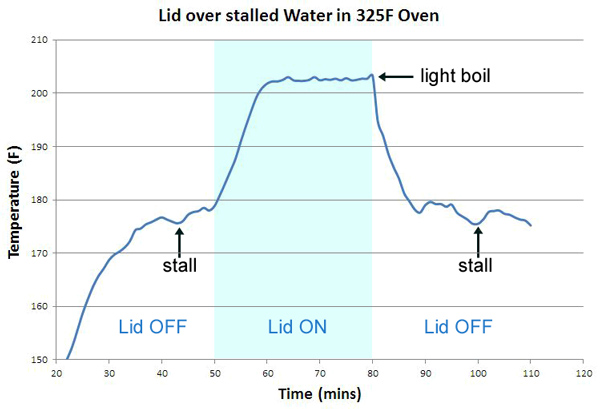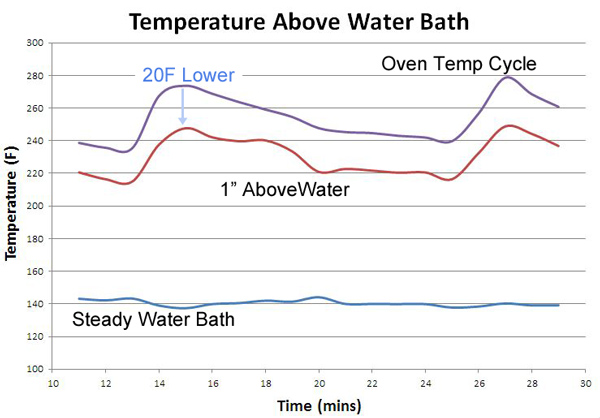| g e n u i n e i d e a s | ||||||
 |
 |
 |
 |
 |
 |
 |
| home | art and science |
writings | biography | food | inventions | search |
| time and temperature wait for no one |
|
August 2011 A mantra in life and love, as well as barbecue, is that "slo' and lo' is the way to go". Barbecue chefs take this advice to heart. It's not unusual to cook at 250F for a half a day or more, and some pit masters swear by a mere 185F. Certainly, meat exceeding an internal temperature of 200F verges on "boiled", and is likely to be tough and flavorless. How hard can it be to maintain 225F for an entire day? Surprisingly difficult, as it turns out, which is why so many barbecue recipes suggest slo' and lo' is enhanced by placing the meat on a grating suspended over a water bath. Or, by simply placing a bowl of water somewhere in the smoker. Outside the world of grilling, plenty of kitchen recipes suggest nestling a piece of meat on top of a thin layer of wet vegetables in the bottom of a tall open pot- presumably roasting and braising simultaneously. Puddings and many delicate foods are baked submerged in a Bain Marie water bath for control. So its not a crazy idea. But does it make sense for the backyard barbecue chef? Well, it turns out a water tray can significantly improve the taste and texture of cooked meats- providing you understand the principles. Most ovens, grills and smokers are anything but stable. This chart compares the internal temperature of a temperature controlled- pellet smoker, a well-insulated electric smoker with a primative bimetallic thermostat, a high-end kitchen oven, and a gas grill with no temperature control:
While they all maintain a pretty consistent average temperature, over minutes and hours the instantaneous readings can drift up or down by 20F. Out of 250F! Beyond the intrinsic temperature drifts of most ovens, hot air rises. Its not unusual to measure a 5-10F thermal gradient per inch- that is, the top of the oven might be 50F hotter than the bottom. Add into the mix wind currents flowing through the vent, rain, uninsulated gaps, hot spots over electric heating elements or gas burners, ands it's a miracle dinner makes it to the table. In real ovens, you might be cooking pork shoulder at 300F instead of 250F, depending on its position in the grill. Or, you might be averaging a steady 250F, but occasionally hitting 350F, and wondering why the glaze burned or picked up an off-flavor. Convection ovens try to erase this non-uniformity by vigorously stirring oven air with a fan. Unfortunately, measurements demonstrate this bandaid is only partially effective- air currents are blocked by the cooking trays, and remains stagnant in the corners. Commercial ovens (and large dedicated barbecue rigs) solve the problem directly by rotating food on a spit, or spinning around on a carousel from left to right, or on a Ferris wheel from top to bottom. But for the rest of us, a practical, low cost, versatile and effective solution to the oven problem remains an issue. There are three common, and on their face plausible, ways to achieve consistent lo' and slo'. The first suggests adding thermal mass to the cooker. This mass supposedly "moderates" the cooker's temperature swings, because it absorbs or releases heat at a steady pace. The second suggests placing a heat spreader between the heat source and the meat. This sheet of metal or ceramic water tray shadows the direct (e.g coal, electric element, ..), converting localized radiative heat into a broader and more uniform source. Finally, there is a water tray in lieu of the heat spreader. This tray also spreads out the heat, and rerportably cools the air if the temperature rises too suddenly. Plus adding moisture to the oven, which is reputed to slow the cooking time and increasing tenderness by "pushing" moisture back into the meat. Let's separate fact from fiction. Technique 1: Thermal Mass If you place a hot rock in a well-sealed beer cooler, the interior will quickly rise up to match the rock's temperature. There will be few if any temperature fluctuations (but temperature gradients from top to bottom stubbornly persist due to the bouyancy of hot air). However, real ovens are not this well sealed, especially smokers. Air currents are a necessary fact of life, and these currents undermine the value of greater thermal mass. The reason is "thermal conductivity". Air is an excellent insulator with low thermal conductivity. You can place your hand 1/4" away from a hot cast-iron handle with no pain-- touch the handle, and expect third degree burns. Similarly, when a cold air current moves into the smoker past the meat, compensating hot air from the hot-rock moderator simply can't flow back to the meat fast enough- too much thermal resistance from the intervening air. This is true whether the thermal mass is a rock placed to the side of the meat, or thick ceramic walls. In fact, an active feedback system (like a PID controller adjusting the gas burners or coal air supply) kicks in more heat, on demand, beating a rock hand's down. Thermal mass does help restore oven temperature after opening the door or adjusting the vents, but has little effect on the minute-to-minute flcutuations. Conclusion: thermal mass does not lead to temperature stability. It's actually pretty difficult to make the ENTIRE oven stable and still functional and flexible. Perhaps a better technique is generating localized stabilty in and around the meat. Which leads us to: Technique 2: Heat spreader
Technique 3: Water Tray If you placed a tray of water on a stove top burner, with a hunk of meat suspended above, the water quickly comes to a boil and steams the meat into submission. That's because direct and radiative heat are such efficient thermal sources, the water does not have time to evaporate before it angrily dissassociate into steam. But, if you place the same tray into an oven, which indirectly heats the water bath with hot air, the water can evaporatively cool faster than it draws heat from the air (this is the same reason meat temperature stalls for hours during barbecue). Air's poor thermal conductivity prevents the oven's heat from overwhelming the evaporative cooling rate. So an indirectly heated water tray in a smoker will never boil, and its temperature will plateau depending on the smoker's temperature. As this water tray in a well-insulated electric smoker demonstrates: Even though the cooker is at 250F, the water stalls at around 165F. In a 500F convection oven, the stall reaches only 190F, an amazing 20 degrees below boiling and 310F lower than the oven. What happens if you interfere with evaporation? Well, the cooling effect disappears in response. This experiment filled a 6" wide pot with water, let it stall, and then temporarily replaced the lid. Water molecules that leave. Within minutes, the pot gently starts to boil. Removing the lid quickly recovered the lower temperature stall.
We also measured the temperature gradient ABOVE a pan of water. In this case, a 12"x9" baking pan filled with 48 ozs. of water:
There is much to learn from the graph. First, the water bath's temperature only varies by a degree or two, while the oven cycles by tens of degrees. So far, so good. But we don't barbecue in water, we cook in air. Then notice, even 1" above the water tray, the temperature is barely 20F lower than the rest of the oven. And it varies in sync with oven- in other words, there's very little moderation of the fluctuations. More confirmation that air is a poor thermal conductivitor, and that additional thermal mass does not lead to thermal stability. Before explaining how we can use a water tray to advatage, there are some important insights for grilling and cooking in general.
Now that the principle is demonstrated, we cooked two, skinless boneless chicken breasts in a 325F oven. One above the water bath, one on a tray to the side. Its important to pre-heat the oven with the water bath inside, so the liquid is already evaporating when the chicken is placed on the trivet. Otherwise, 20 minutes will go by without the benefit of evaporative cooling. Also, avoid a convection oven- they tend to blow away the cool layer of moisture sitting above the trivet. It's also one reason we chose a high-sided pot.
Finally, while the humidity itself does not "penetrate" the meat, and protein chemical changes will squeeze out juices like myoglobin not matter what, it will gently slow down the evaporation of lightly bound water, leaving the meat slighty moister. In an outdoor cooker, the environment is far less controlled than the kitchen. So here is the first advantage of cooking above a water tray- large swings in oven (or grill or smoker) temperatures are moderated by the water bath- its a poor-man's temperature controller. The second advantage is the absolute temperature itself- if you don't want to overcook meat, but still allow time for collagen to melt and flavors to develop, you have to hold the the muscle around 170-190F for at least an hour. The water bath buys you time and temperature. For example, in a convection oven at 325F the same sized breasts cooked in only 40 minutes. They weren't bad, but no where near as flavorful or tender as the water bath breasts which took almost . Despite the fact they lost the same amount of weight during cooking. Based on these experiments (and real-world barbeque experience), the only way a water bath makes sense is to place it directly below the meat, and not on top of the heat source. What won't work (despite hoary advice to the contrary), is
|
|
-------------------------------------------------------------------------------------------------------- Additional articles on kitchen science can be found HERE.
|
 Contact Greg Blonder by email here - Modified Genuine Ideas, LLC. |


